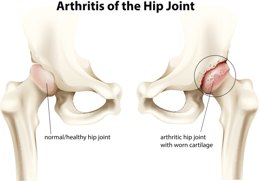The natural wear and tear of the cartilage on the ball and socket joint of the hip can lead to hip arthritis. This article has provided comprehensive information on the symptoms of hip arthritis.

Arthritis is a condition in which the joints of a person get inflamed. The most common form of arthritis is osteoarthritis. When the joints of the hip get inflamed, it is called hip arthritis. The pelvic bones are connected to the thigh through the hip joints. People over the age of 50 are commonly affected by hip arthritis. It is not very clear as to why some people are more prone to getting afflicted by it than others. There are certain factors like obesity, hereditary condition, and hip fracture or any injury to the hip joint that may be responsible.
Symptoms Observed
✔ Hip arthritis may have subtle symptoms initially. The main symptom being hip pain, which is not restricted to the hips only but radiates down the thighs. People with this condition often show varying periods of pain, like certain weather conditions trigger the onset of symptoms or curtail the same. Cold weather generally intensifies the pain in the hip joint. The pain worsens if the condition is not treated over the years.
✔ The hip joints tend to become stiff with time. The cartilage, that covers the head of the thigh bone, gradually wears out causing the bones to rub against each other. This leads to stiffness and inflammation.
✔ With the progress of the disease, the range of rotation also decreases. Range of rotation is the extent to which a joint can be extended or retracted. This makes it difficult to bend down and the hip movement also decreases. Prolonged sitting also soon becomes very painful.
✔ Many patients walk with a limp and often complain that they feel one of their legs has become shorter than the other. Patients may also hear or feel a crackling noise in their hip joint while walking. Walking soon becomes a difficult task for such people. The flaring pain decreases when one takes frequent rest while walking.
Treatment Options
Treatment includes weight loss if the patient is obese. Weight reduction lowers the stress on the joints and makes regular activities less painful. Patients are also advised to use walking aids to reduce the weight on the affected area. Physical therapy is also prescribed to decrease the chances of atrophy. Anti-inflammatory drugs are advised by medical practitioners to decrease the pain. In certain cases, hip replacement therapy is also carried out.
Impact of Hip Arthritis on the Day-to-day Life
A patient of hip arthritis can manage to walk over one or two blocks with slight pain. Swimming and cycling are relatively less painful than walking. Increase in activity increases the pain. Climbing stairs or standing for a long time may aggravate the pain in the hips. As the condition progresses, the pain may radiate in the groin, side of the hip, buttocks, lower back, etc. Sometimes, the knee joint also becomes painful. The patient finds it difficult to carry out the tasks of daily routine, like tying of shoelace, bending, getting up from a chair, etc.
A patient should take proper care when suffering from hip arthritis. Consult the doctor regarding any doubts pertaining the symptoms or intervention methods.
Disclaimer: This Buzzle article is for informative purposes only and should not be used as a replacement for expert medical advice.


 Arthritis is a condition in which the joints of a person get inflamed. The most common form of arthritis is osteoarthritis. When the joints of the hip get inflamed, it is called hip arthritis. The pelvic bones are connected to the thigh through the hip joints. People over the age of 50 are commonly affected by hip arthritis. It is not very clear as to why some people are more prone to getting afflicted by it than others. There are certain factors like obesity, hereditary condition, and hip fracture or any injury to the hip joint that may be responsible.
Arthritis is a condition in which the joints of a person get inflamed. The most common form of arthritis is osteoarthritis. When the joints of the hip get inflamed, it is called hip arthritis. The pelvic bones are connected to the thigh through the hip joints. People over the age of 50 are commonly affected by hip arthritis. It is not very clear as to why some people are more prone to getting afflicted by it than others. There are certain factors like obesity, hereditary condition, and hip fracture or any injury to the hip joint that may be responsible.